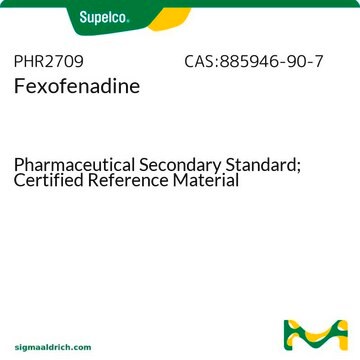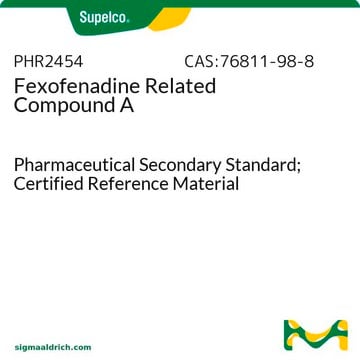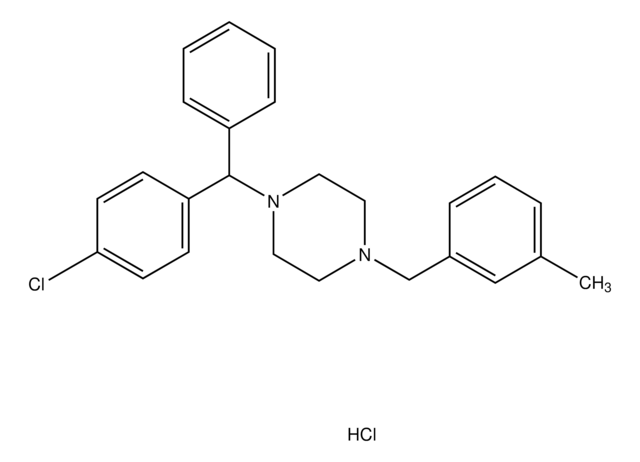F9427
Fexofenadine hydrochloride
>98% (HPLC)
Sinónimos:
Fexofenidine hydrochloride, MDL 16455 hydrochloride, Terfenidine carboxylate hydrochloride
About This Item
Productos recomendados
Análisis
>98% (HPLC)
formulario
powder
condiciones de almacenamiento
desiccated
color
white to beige
solubilidad
DMSO: soluble ≥5 mg/mL
emisor
Sanofi Aventis
temp. de almacenamiento
−20°C
cadena SMILES
Cl[H].CC(C)(C(O)=O)c1ccc(cc1)C(O)CCCN2CCC(CC2)C(O)(c3ccccc3)c4ccccc4
InChI
1S/C32H39NO4.ClH/c1-31(2,30(35)36)25-17-15-24(16-18-25)29(34)14-9-21-33-22-19-28(20-23-33)32(37,26-10-5-3-6-11-26)27-12-7-4-8-13-27;/h3-8,10-13,15-18,28-29,34,37H,9,14,19-23H2,1-2H3,(H,35,36);1H
Clave InChI
RRJFVPUCXDGFJB-UHFFFAOYSA-N
Información sobre el gen
human ... HRH1(3269)
¿Está buscando productos similares? Visita Guía de comparación de productos
Aplicación
Acciones bioquímicas o fisiológicas
Características y beneficios
Producto relacionado
Código de clase de almacenamiento
11 - Combustible Solids
Clase de riesgo para el agua (WGK)
WGK 3
Punto de inflamabilidad (°F)
Not applicable
Punto de inflamabilidad (°C)
Not applicable
Equipo de protección personal
Eyeshields, Gloves, type N95 (US)
Certificados de análisis (COA)
Busque Certificados de análisis (COA) introduciendo el número de lote del producto. Los números de lote se encuentran en la etiqueta del producto después de las palabras «Lot» o «Batch»
¿Ya tiene este producto?
Encuentre la documentación para los productos que ha comprado recientemente en la Biblioteca de documentos.
Los clientes también vieron
Artículos
Discover Bioactive Small Molecules for ADME/Tox
Contenido relacionado
Explore protein pathway analysis including chemical library screening and modulating pathways with small molecules.
El estudio de las vías proteicas es una parte fundamental de la investigación en el descubrimiento de fármacos y el desarrollo de medicamentos. Explore más sobre el análisis de las vías proteicas, incluidos el cribado de quimiotecas, la investigación de la actividad de proteínas y enzimas, y la modulación de las vías proteicas mediante la utilización de moléculas pequeñas.
Nuestro equipo de científicos tiene experiencia en todas las áreas de investigación: Ciencias de la vida, Ciencia de los materiales, Síntesis química, Cromatografía, Analítica y muchas otras.
Póngase en contacto con el Servicio técnico













